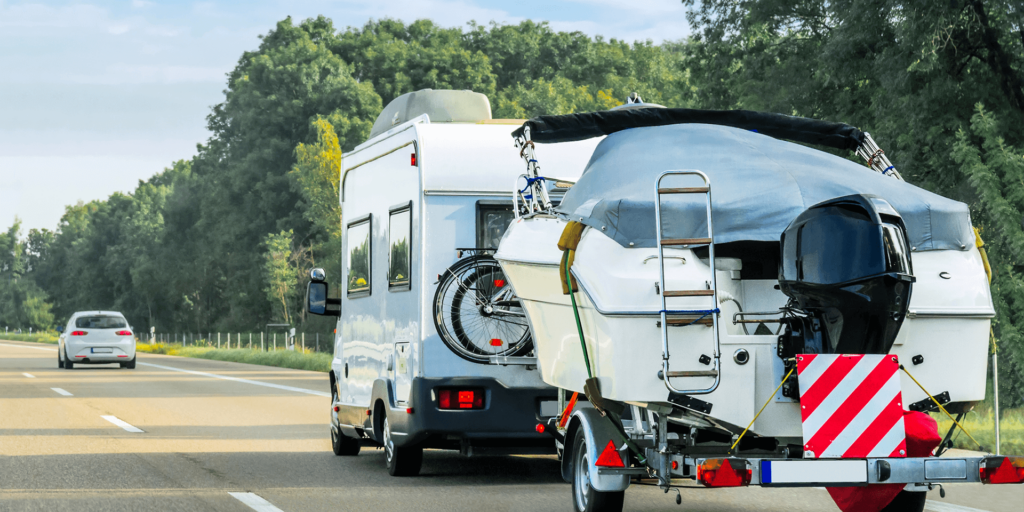Quick Navigation:
- What Is Winterizing a Boat?
- How Do You Winterize Your Boat?
- When to Winterize Your Boat
- Winterizing a Boat Engine
- Preventing Mold and Mildew in Storage
- Boat Winterization Tips
- Winterize Your Boat Checklist
- Boat Winterizing FAQ's
As the weather gets colder and the winter chill sets in, the time to prepare your boat for the season has finally arrived. If you're new to boating and this is your first year getting a boat ready for winter, you'll need to know how to winterize a boat. What does it mean to winterize a boat, and is it even necessary?
Our boat winterization guide will show you why you should winterize your boat and how to properly winterize a boat so your vessel is protected during the harshest months of the year. With our boat winterization tips, you won't have to worry about the frigid drops in temperature, icy snowfall and other damaging elements when your boat is left unused during the off-season. With the right care and attention, your vessel will be ready and raring to go when spring rolls around again.
What Is Winterizing a Boat?

Winterization is preparing your boat for cold weather. At the very least, winterization involves draining any water stored on the boat or replacing it with enough antifreeze liquids to protect it from freezing temperatures. If you live in a northern state that experiences snow and freezing temperatures, winterizing is absolutely necessary.
Winterizing a boat means going through the necessary steps of protecting the engines, water tanks and additional systems from damage that cold and harsh conditions cause. The time it takes to practice preventative care can end up saving you thousands of dollars in potential repairs. Winterizing involves preparing the parts of your boat that won't be used until it comes out of storage.
Changing the oil, placing plenty of protective layers around it, and storing it indoors are necessary steps for winterizing.
What happens if you don't winterize your boat? The water inside certain spaces and systems freezes and expands, which causes major damage. Precipitation is more acidic than regular water, so the salt, acid and general corrosive buildup can damage parts of the engine. Leaving water in your systems can result in cracks in the engine block or exhaust manifolds. Repairs from failing to winterize can be costly and time-consuming.
If you're still wondering, "do I have to winterize my boat?" The answer is absolutely! Fortunately, we're here to show you how. We'll also cover what is involved in winterizing a boat.
How Do You Winterize Your Boat?
Winterization comes with several steps, and the process varies depending on what type of boat you have and where the engine sits. Different engine types call for varying levels of care. However, regardless of what type of engine your vessel has, standard winterizing procedures must be carried out for all engine types.
When it comes to winterizing a boat, the engine is your first priority. While other systems are also important, the liquids that sit inside your engine need to be refreshed so long-term motor damage doesn't arise as your boat sits in storage.
Let's discuss how to winterize your boat engine and systems that hold water, so every inch of your vessel is protected from the inside out.
When to Winterize Your Boat
When should you winterize your boat, and does location matter? These are the most common questions for new boat owners, especially those who live in states that don't see much snow. You don't want to wait too long to winterize. Putting it off means risking the onset of corrosion and doing the work in the bitter cold.
When to winterize boats and other watercraft can be challenging to pinpoint. The weather can go from sunny to freezing within hours in the days of early autumn. The shortest answer to this question is to winterize before the first hard freeze. If you're a boater who lives up north, this can be as early as September. But other states will have some more leeway, depending on how warm it stays going into October and November.
If you plan on taking your boat to a dealership or mechanic to get it serviced, you'll want to schedule your appointment as soon as possible. You don't want to be kept on the waitlist while it's already snowing outside.
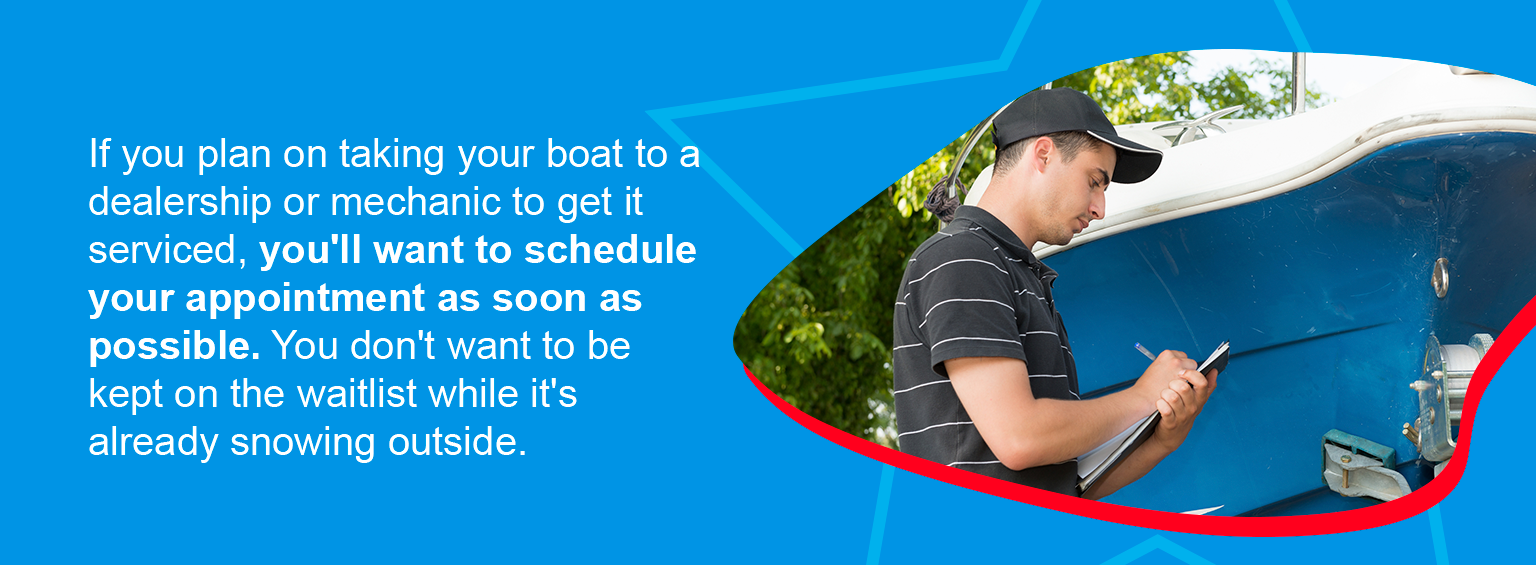
Take It Out One Last Time
The winterization process starts weeks before the cold weather hits. With one last trip on the water, you can take your time checking that everything is in working order and making notes of any repairs needed.
We often push off small repairs or easy modifications because they may not seem urgent. However, outdated electronics, ripped upholstery, dirty carpeting and other minor projects can cause bigger problems down the line. Winterization is the perfect time to take care of your vessel and give it the love and attention it needs, especially since it won't cut into your time on the water.
Winterizing a Boat Engine
Listing out what needs to be done to winterize a boat makes the process sound more complicated than it really is. At most, it should only take you a few hours to prepare your vessel for the cold weather. And by next year, it will go even faster because you know what you're doing. Winterizing is simpler than it seems. The smallest precautions, such as adding antifreeze and fogging the engine, will make the biggest difference in keeping your boat safe.
Follow these steps to protect your boat against corrosion. You should easily be able to do it all yourself.
1. Replace the Oil
When oil is left to sit, the moisture and acids affect nearly every part of the engine. The oil needs to drain out before your boat is stowed away for the winter. To change out the oil, start by warming up the boat engine while it is still in the water. This will allow some of the dirty oil and impurities to drain out. Next, use quality filters to change the boat's oil and filter for winterization.
2. Fog the Engine
To fog the engine, spray fogging oil into the carburetors while the engine is still running. Continue spraying the fog oil until the engine stalls, and then move onto spraying the cylinders. Fogging your boat varnishes the engine with a layer of wax to prevent corrosion inside the engines. So, this is an important step regardless if they are inboard or outboard units.
Every boat manufacturer has their own recommendations for what products to use for their watercraft engines. All it takes is a simple online search, and you'll find the best fog oil for your engine.
3. Flush the Engine
Flushing the engine is a crucial step in the winterization process. You want your engine to be clean and free of particles. Salt can cause substantial damage to metal, so this step is even more critical if you sail your boat on the ocean. If you don't drain the engine, you risk the cooling chambers freezing and potentially cracking.
To drain the engine on your inboard or stern-drive, locate and open the petcocks. They are placed under the manifold and on the sides of the engine block. Take out the water-pump hose and let it drain until it's completely empty.
4. Add Antifreeze Where Necessary
After you have drained the water, you will also need to add marine-grade antifreeze. Adding antifreeze to equipment that has held water will create a protective coating that prevents freezing, cracking and other damage usually sustained during the coldest season. You will want to add antifreeze to the engine block, water tank and water lines.
5. Stabilize the Fuel
Treating the fuel with a stabilizer will prevent gum and varnish from building up while your boat is in storage. It's important to follow the manufacturer's directions for this step exactly as they are laid out, as there are very specific ratios for each engine size and type. Allow the stabilized fuel to completely flow through the fuel system. This can be done by reattaching the flushing muffs, running the water and restarting the engine. Let the motor run for 10 minutes, then turn it off.
Preventing Mold and Mildew in Storage
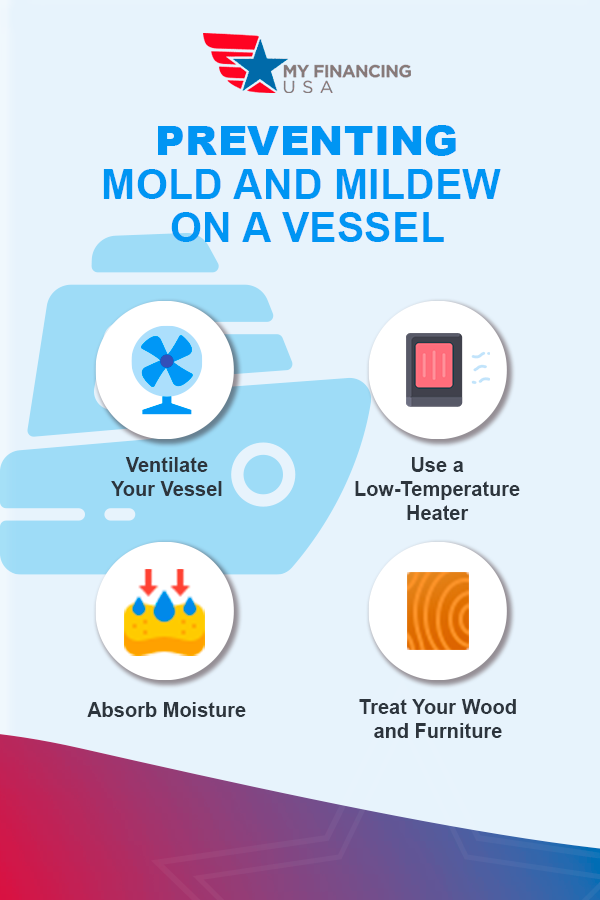
Preparing your boat for the winter includes caring for the cabin, galley, saloon or any indoor space in your watercraft. Why do you have to winterize a boat on the inside? The simple answer is mold.
Mold is sometimes called "the silent killer" because it grows in the most neglected and hard-to-reach places. When hidden out of sight, it causes serious health issues like asthma and shortness of breath, fever, rashes and even cancer.
Your vessel is already susceptible to mold buildup because of how much time it spends in the water. Your boat also has tanks of water that sit still when it's not in use. As your boat is tucked away for the winter, it becomes a breeding ground for mold and mildew, even if it isn't docked in the water. Here is everything you need for what do you have to do to winterize a boat on the inside.
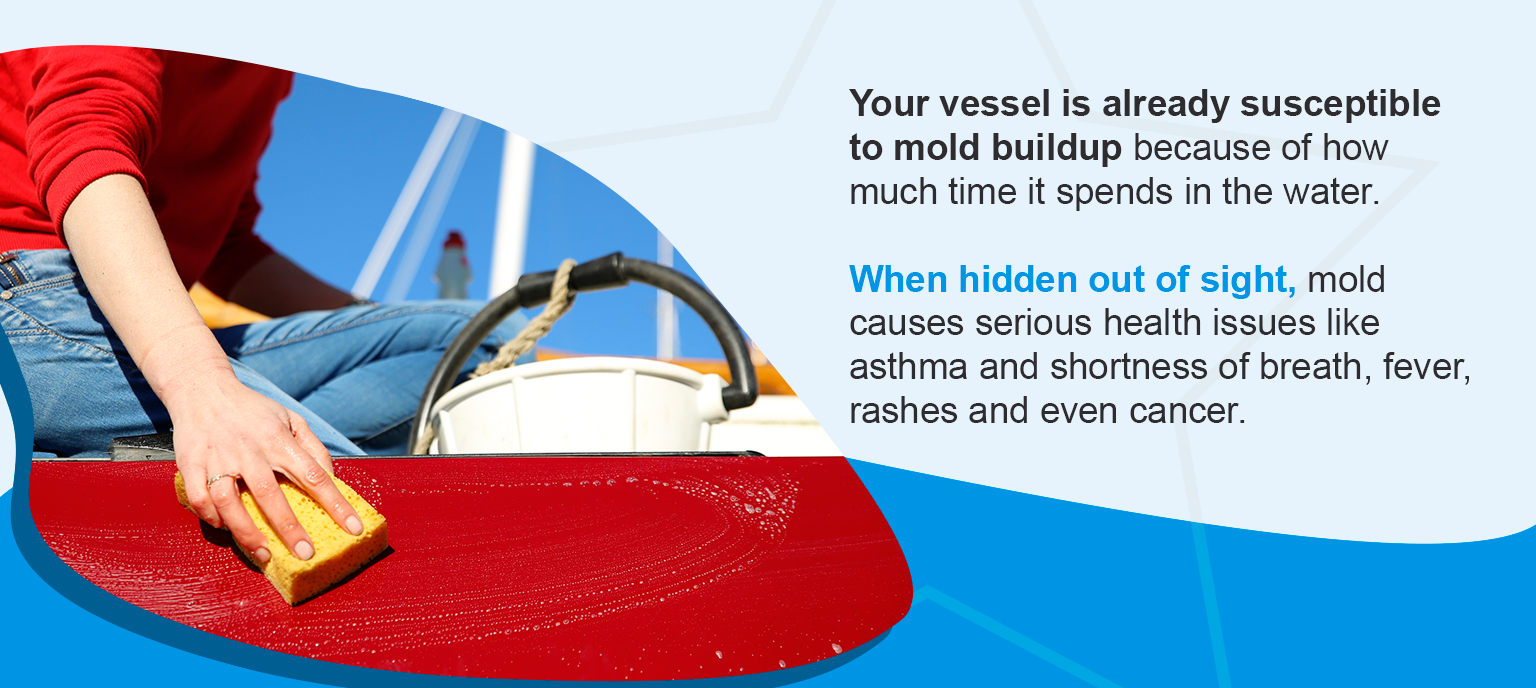
1. Ventilate Your Vessel
Ventilation is key to battling still air that traps moisture and contributes to mold. Active ventilators, like solar vents, push air around with fan blades and are designed to keep air moving around the boat while also preventing water from entering. Passive ventilation systems, such as cowl vents and louvers, use wind and air without relying on moving parts. Another affordable option for circulating the air on your ship is to open all of the doors, lockers and other closed spaces.
2. Use a Low-Temperature Heater
Low-level air heaters are simple, affordable and effective in maintaining a clean and mold-free environment. Of course, cabin heaters only work if you have a power source. However, they are usually energy-efficient and won't pose a threat, so you can leave one in your boat over the winter even if it's unattended.
Cabin air heaters only heat the air inside your boat by one or two degrees above the outside temperature. They work well in keeping mildew at bay because they reduce the overall humidity inside the cabin.
3. Absorb Moisture
Another proven method of limiting humidity in any enclosed space is moisture-absorbing crystals and mothballs. Absorbent crystals capture and convert moisture to prevent mold and corrosion damage. You can also use mothballs and get the same effect while also keeping critters from building a winter home in your vessel.
Whichever method you choose to absorb moisture, be sure to place them in your lockers, cabinets and any other small spaces.
4. Treat Your Wood and Furniture

One effective and affordable tip for protecting your furniture while your boat is put to bed is to apply lemon oil to your wooden surfaces. This simple method will prevent mildew from forming when applied liberally and to all wooden surfaces.
Secondly, you should lift the cushions on your bed, couches and chairs. This way, if water coming from leaks or condensation does cause humidity, your cushions won't be affected.
Lastly, visit your vessel every three weeks or so to make sure the drains haven't clogged, the bilges are dry and nothing is out of place.
Boat Winterization Tips
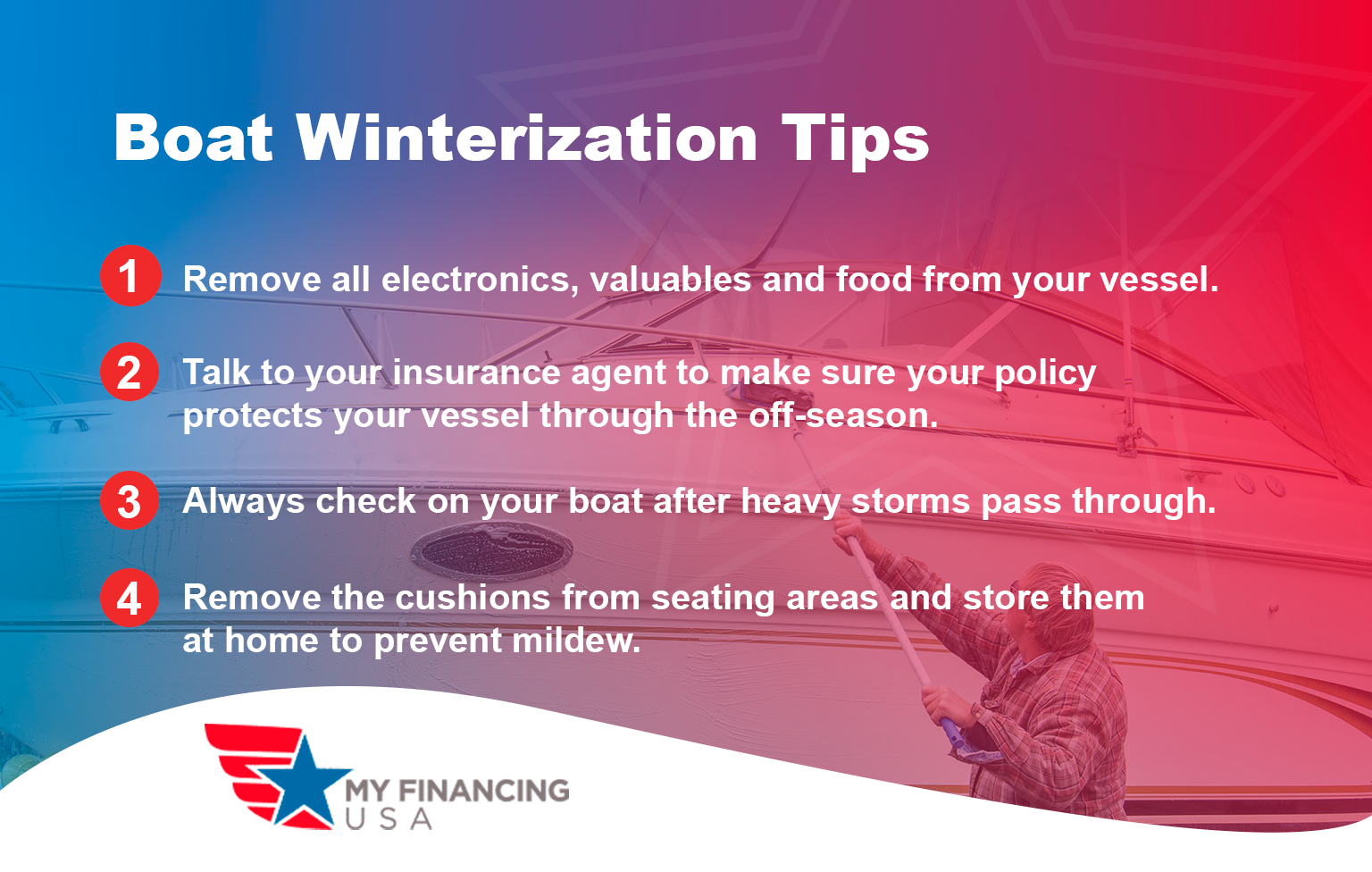
Here are our top 10 tips for winterizing your boat, from the small details to the big tasks!
- Open all of your seacocks and drains so they don't sustain damage from being frozen.
- Don't ever tie off boat cover to boat stands.
- Make sure you remove all electronics, valuables and food from your vessel.
- Store your boat with the stern down, so melting snow and ice will drain through the scuppers.
- Talk to your insurance agent to make sure your policy protects your vessel through the off-season.
- Always check on your boat after heavy storms pass through.
- Charge your battery until it is fully charged, then disconnect it. If possible, bring the battery home with you for storage.
- Clean your vessel thoroughly on the inside and outside before locking it up for the winter.
- Air out your boat after cleaning it so fresh air can circulate and refresh the space.
- Remove the cushions from seating areas and store them at home to prevent mildew.
Winterize Your Boat Checklist
It's easy to get caught up in the process of getting your boat ready for winter. For the times when you're at a loss for what you need to do to winterize a boat, look at our winterizing a boat checklist to keep you grounded and focused.
- Fill the motor with new fuel and add a stabilizer.
- Change the oil and filters.
- Check coolant levels.
- Add antifreeze to the raw-water-cooling system.
- Pour antifreeze in the water strainers.
- Fog the engine cylinders.
- Charge the battery and unplug.
- Change the oil and filter in the generator.
- Change the generator's fuel separators.
- Add antifreeze to the raw-water-cooling system.
- Add coolant if you have a freshwater-cooling system.
- Fill strainers with antifreeze.
For Outboard Motors
For outboard motors, make sure you:
- Fill fuel tanks and add a stabilizer.
- Drain the gear case and add a lubricant.
- Flush the engine with fresh water.
- Replace anodes if necessary.
For Below-Deck Boats
If you have a below-deck boat, follow these steps:
- Empty the holding tank and add antifreeze.
- Drain the water heater and bypass it.
- Drain the water system and add antifreeze to it.
- Add antifreeze through refrigeration units.
- Drain all places where water pools.
- Disconnect propane and close valves.
- Secure hatches and ports, turn off circuit breakers.
- Remove valuables and food.
Final Touches
A few finishing touches include:
- Tie off steering.
- Cover boat.
- Lock up and close the storage unit.
Boat Winterizing FAQ's
If you still have questions about winterizing your boat, you're not alone. The first few years of putting your boat to bed require extra care and attention. But with time and practice, these are steps that you will undoubtedly master.
What Temperature Do You Need to Winterize Your Boat?
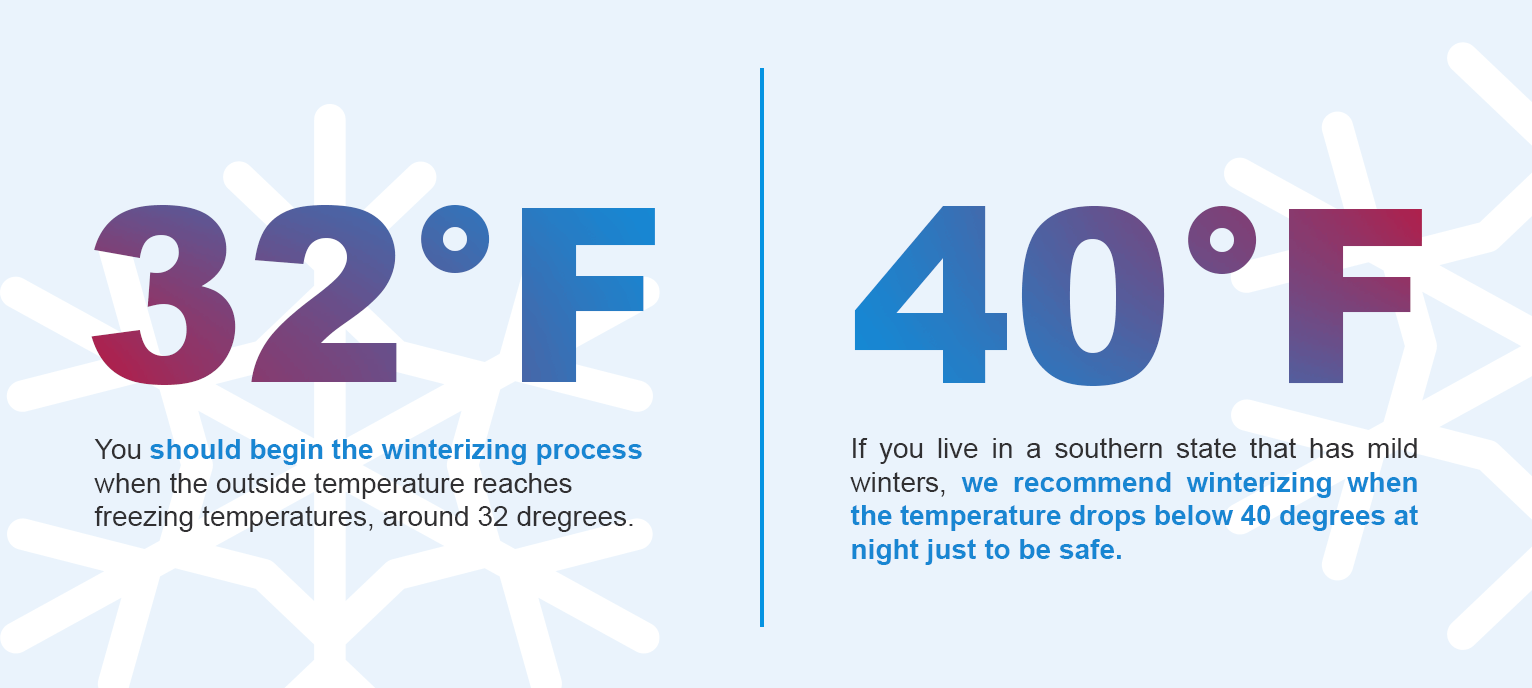
You should begin the winterizing process when the outside temperature reaches freezing temperatures, around 32 degrees. Even though saltwater freezes at 28 degrees, you should still winterize as soon as possible.
You might be wondering when do you need to winterize your boat if temperatures vary in your state? Since weather trends can be unpredictable, even sunny states can experience frost and harsh weather. If you live in a southern state that has mild winters, we recommend winterizing when the temperature drops below 40 degrees at night just to be safe.
Should I Winterize My Boat if I Already Made Repairs Over the Summer?
Winterizing requires more than making repairs. If you have already changed the oil, cleaned above and below deck, and taken care of major repairs, you're already off to a great start. The most important part of winterizing a boat is draining the water from all systems and containers. Taking precautions against mold is also crucial.
How Do You Winterize a Boat in Southern States?
For the sake of insurance and saving money, you should still winterize even if you live in a Southern state. At the very least, you should perform regular maintenance to keep your vessel in top shape. When should you winterize your boat if you live in a warm state? We say you should winterize from November to April.
Should You Winterize Your Boat if it's Brand New?
Do you have to winterize your boat if it's already in tip-top shape? Well, it sounds like you're almost done with winterizing! All you have to do is drain the water systems, charge and remove the battery and add moisture-absorbing crystals to your storage spaces. Remember that boats made out of fiberglass are susceptible to cracking, so covering them properly should be a top priority.
Do I Need to Winterize My Boat in Heated Storage?
Many new boat owners ask "do you need to winterize a boat when it is kept in a heated environment?" This is a fair question because you don't run the risk of freezing temperatures causing damage and corrosion to your engine. However, you should still winterize because the oil in your motor will separate, and the gasoline has an expiration date. You may also want to add mothballs to your cabin and galley to thwart off critters.
Do You Need to Winterize Your Boat if Stored Inside?
Regular maintenance is an important part of every boat winterization. So, if you're storing your boat inside, you should still cover the vessel with a tarp or shrink wrap. Many new boaters make the mistake of storing their vessels and leaving out the final step of covering it. Tarp or shrink-wrap will keep your boat protected and clean while it's stored away.
Find the Best Rate on a Boat Loan Built With Your Budget In Mind
Let My Financing USA's experts help you get a loan that is personally fit just for you. Skip the headache of filtering through dozens of websites and take just five minutes to fill out our simplified boat loan application. You'll receive a phone call from a real person who is trained to get you the best rates.
Not sure if a boat loan is right for you? No problem! Learn more about our boat loans here and see for yourself how we can help you afford the boat you've always wanted.
Get the boat you want, at a price you can afford, at the best rate on the market with My Financing USA. Apply online today!





